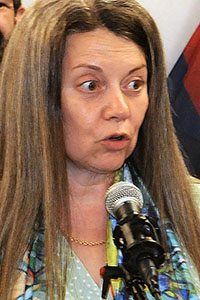Key Points:
-
Congressman chooses to run for governor in 2026, leaving behind vacancy
-
21 candidates express interest in running to fill vacant spot in CD1
-
CD1 has a republican voter edge
With less than a year until the 2026 election, the field of candidates hoping to replace U.S. Rep. David Schweikert in Congress is starting to take shape.
Following Arizona Republican Party Chairwoman Gina Swoboda’s October announcement to run in Arizona’s 1st Congressional District, Republican and Scottsdale resident John Trobough filed paperwork with the Secretary of State’s Office to run in the district.
Schwiekert is running for the Republican nomination for governor in 2026 and entering a crowded field with fellow GOP gubernatorial candidates Andy Biggs and Karrin Taylor Robson. Schweikert’s decision to run for governor leaves his district without an incumbent for the first time in more than a decade.
As of Nov. 20, nine Republicans and 12 Democrats have filed statements of interest to run for Schweikert’s seat in a district that could help decide which party controls the U.S. House in the midterm elections.
Trobough, the former president and CEO of Boeing subsidiary and cybersecurity analytics company Narus, is campaigning as a Silicon Valley Republican who would help advance President Donald Trump’s America First agenda and outcompete China.
In 2016, Trobough was selected as a fellow in the Presidential Innovation Fellows program, which awards top technologists and innovators to improve government services.
A memo sent from Trobough to the White House and the Arizona Capitol Times also notes Trobough is prepared to contribute at least $1 million of his own funds to his campaign. Consultants close to Trobough also expect him to formally announce his candidacy by Dec. 1. One group Trobough is seeking support from is Turning Point USA, the conservative advocacy organization that was led by the late Charlie Kirk.
Trump has endorsed Swoboda, but some Arizona Republicans have turned against her. The founder of the Arizona Freedom Caucus, Sen. Jake Hoffman, R-Queen Creek, has accused Swoboda on social media of pushing Schwiekert to run for governor in an attempt to thwart Biggs’s campaign and has called her a Democrat.
Trobough declined to comment to the Arizona Capitol Times about his filing of a statement of interest, and Swoboda did not respond to a request for comment from the Arizona Capitol Times.
Other Republicans who have filed statements of interest include: Brandon Sproles, Joe Russell, Kaitlin Purrington, Brandon Sowers, Paul Reevs, Jason Duey and Dusko Jovicic.
CD1 covers northeast Maricopa County, encompassing northeast Phoenix, Scottsdale, Paradise Valley, Cave Creek and Fountain Hills. The Arizona Independent Redistricting Commission considers the district highly competitive and gives Republicans a slight edge with a 2.6% vote spread advantage.
Schweikert defeated Democrat and former state Rep. Amish Shah in the 2024 general election by just under 4%, or about 16,500 votes.
Shah is running again in the Democratic primary to try for Schweikert’s seat, along with his 2024 Democratic primary opponent Marlene Galán-Woods.
Other Democrats who have filed statements of interest include: Brandon Donnelly, Brian Del Vecchio, Tammi Medlin, Andres Barraza, Angie Montoya, Mark Robert Gordon, Rick McCartney, Jonathan Treble, David Redkey, Daniel Lucio and Victor Weintraub.
Treble, the founder of smart amenities company WithMe, has amassed the most cash among Democrats by the close of the third quarter campaign finance reporting period in October, becoming the first Democrat to cross the $1 million threshold in total cash raised for the 2026 election cycle. His total fundraising is more than Shah and Galán-Woods raised combined through the third quarter, with more than $1.7 million raised and $1.3 million in total cash on hand.
The more than 207,000 registered Republicans in CD1 outpace Democrats by more than 60,000, according to the Secretary of State’s Office October voter registration report. There are another 181,000 “other” voters in the district.






























